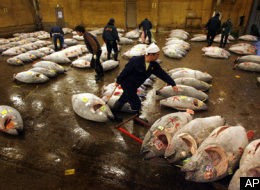I found this article this morning:
EU officials warn of disappearing cod
 By RAF CASERT, Associated Press Writer Raf Casert, Associated Press Writer – Sat Oct 17, 3:45 am ET
By RAF CASERT, Associated Press Writer Raf Casert, Associated Press Writer – Sat Oct 17, 3:45 am ETBRUSSELS – The European Union's executive body is calling for sharp cuts in the amount of cod fishermen can catch next year, pointing to estimates that the fish is close to extinction in some major fishing areas around Europe.
Officials warned Friday that only steep catch cuts will prevent the disappearance of a species prized for centuries for its flaky white flesh.
The European Commission said recent studies showed cod catches in some areas are far outstripping the rate of reproduction. It is calling for up to 25 percent cuts in some areas.
"We are not that far away from a situation of complete collapse," said Jose Rodriguez, a marine biologist with the environmental group Oceana. He and other environmentalists said pressure from the fishing industry had kept quotas at levels too high to sustain a viable populations around Europe, while lack of enforcement meant illegal fishing made the problem worse.
Scientists estimated that in the 1970s there were more than 250,000 tons of cod in fishing grounds in the North Sea, eastern English Channel and Scandinavia's Skagerrak strait.
In recent years, however, stocks have dropped to 50,000 tons.
The European Commission said Friday it would seek in 2010 to cut the catch in some fishing grounds around Britain, France, Spain and much of Scandinavia from 5,700 tons to 4,250 tons.
In the Mediterranean, bluefin tuna has been overfished for years to satisfy increasing world demand for sushi and sashimi. The tuna population is now a fraction of what it was a few decades ago, but the EU's Mediterranean nations last month refused to impose even a temporary ban.
Oceana estimated that illegal fishing doubled the amount of tuna caught.
Meanwhile cod, which once sustained vibrant fishing communities from Portugal to Britain to Canada, is increasingly consumed by the ton as salt cod and fish-and-chips.
"People don't ask for fish and chips, they ask for cod and chips," said Mike Guo, a manager at Great Fish and Chips in Essex, England. "It's a traditional dish."
The depletion of the species has caused the decay and disappearance of hundreds of fishing villages on both sides of the Atlantic.
Overfishing off Canada's maritime provinces exhausted the world's richest cod grounds and forced the government to impose a fishing moratorium. The collapse wiped out more than 42,000 jobs, and 18 years later the fish have still not returned."It was devastating," said Tom Hedderson, minister of fisheries in Newfoundland. "This affected whole communities ... all up and down the coast here in Newfoundland and Labrador."
He welcomed the EU call to cut catches by 25 percent, but suggested more drastic cuts may be needed.
Some Canadian scientists believe the collapse of cod stocks off Newfoundland and Nova Scotia changed the marine ecosystem so dramatically that it may be impossible for cod to recover.
Off Newfoundland alone, cod stocks once exceeded more than 400,000 tons but now scale only 5,500 tons, Hedderson said.
There are signs of recovery of Atlantic cod off New England, however, after years of conservation efforts. And international regulators have reopened some areas off Canada for limited fishing, Canada's Fisheries and Oceans Department spokesman Scott Cantin said.
The fishing industry in Europe, however, is in decline. The number of vessels in the 15 nations that were part of the EU in 1995 has dropped from 104,000 then to 81,000 in 2006. In Britain, employment in the fishing sector sank from 21,600 in 1990 to 16,100 in 2006.
The EU Commission's demand for cod cuts will be discussed by the bloc's 27-member states in a Dec. 14-15 meeting, when the fishing quotas for 2010 will be finalized.
"The scientific prognosis for most stocks is not encouraging, with many in a worse state than last year," Britain's Department for Environment, Food and Rural Affairs said Friday. "This, combined with the difficult economic climate, will mean that the negotiations will be even more challenging this time around."
Keeping fishermen in port with excessive quotas will add to their economic woes, said Bertie Armstrong of the Scottish Fishermen's Federation.
Norway and the EU jointly oversee cod stocks in North Sea, with each party regulating the stocks in its waters.
Norway and the EU will begin annual negotiations on cod stock management in November. Ann Kristin Westberg, deputy director-general of Norway's Fishery Ministry, said her country was unlikely to accept a 25 percent quota.
"We probably want to have it lower," she said. "We would like to point out that stock the EU are involved in managing are in terrible shape."
The cod harvest from the Georges Bank and Gulf of Maine fishing grounds, the two primary New England fishing grounds, in 2007 totaled 3,868 metric tons, the biggest catch since 2003 but far under the landings of the 1980s when fishermen often caught more than 20,000 tons annually.
"The Gulf of Maine stock is responding to the recovery plan, and the Georges Bank stock is recovering but not as much," said Teri Frady of NOAA's Northeast Fisheries Science Center in Woods Hole, Massachussets.
___
Associated Press writers Clarke Canfield in Portland, Maine, Rob Gillies in Toronto, Karl Ritter in Stockholm and Rachel Leamon and Maresa Patience in London contributed to this report.
http://news.yahoo.com/s/ap/20091017/ap_on_sc/eu_eu_threatened_fish











